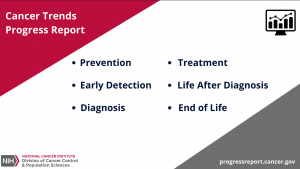The nation's investment in cancer research is making a difference. The rate of death from cancer continues to decline among both men and women, among all major racial and ethnic groups, and for many types of cancer, including the four most common (lung, colorectal, breast, and prostate cancers). The death rate from all cancers combined continues to decline, as it has since the early 1990s. Many people who have had cancer live longer and enjoy a better quality of life than was possible years ago. This steady improvement in mortality from cancer reflects public health prevention and screening initiatives and improvements in the diagnosis and treatment of cancer.
Still, cancer remains a major public health problem that profoundly affects more than 1.7 million people diagnosed each year, as well as their families and friends.
- Cancer is the second most common cause of death in the United States (exceeded only by heart disease), accounting for nearly one in every four deaths.
- The incidence of some cancers is rising.
- The burden of some types of cancer weighs more heavily on some groups than on others. The rates of both new cases and deaths from cancer vary by socioeconomic status, sex, and racial and ethnic group.
- The economic burden of cancer also is taking its toll. As the U.S. population ages and newer technologies and treatments become available, national expenditures for cancer continue to rise and could potentially exceed overall medical care expenditures combined.
Why a Progress Report Is Needed
Since the signing of the National Cancer Act in 1971, our country has vigorously fought the devastating effects of cancer. Now it is time to see how far we have come. The Cancer Trends Progress Report is a series of reports that describe the nation's progress against cancer through research and related efforts. The report is based on the most recent data at the time of analysis from the National Cancer Institute, the Centers for Disease Control and Prevention, other federal agencies, professional groups, and cancer researchers.
The Cancer Trends Progress Report is designed to help the nation review past efforts and plan future ones. The report can help the public better understand the nature of cancer, as well as the results of current strategies to fight cancer. Researchers, clinicians, and community health providers can focus on the gaps and opportunities identified in the report, paving the way for future progress against cancer. Public health officials can use the report to evaluate our progress relative to our investment in cancer research discovery, program development, and service delivery.
What's in the Report
The Cancer Trends Progress Report includes key measures of progress along the cancer control continuum.
- Prevention. The measures in this section cover behaviors that can help people prevent cancer, the most important of which is avoiding tobacco use and secondhand smoke exposure. This section also addresses physical activity, dietary intakes, alcohol consumption, exposure to the sun and chemicals in the environment, smoking cessation, and genetic testing.
- Early Detection. Screening tests help find cancers early, which greatly increases the chances of successful treatment. This section describes the extent to which people are following recommended screening guidelines to detect breast, cervical, colorectal, lung, and prostate cancers.
- Diagnosis. We can learn much about our progress against cancer by looking at the rates of new cancer cases (incidence) and cancers diagnosed at late stages. This section reviews both of these areas.
- Treatment. This section describes common treatment options and measures the rates at which people are undergoing treatments for certain cancers. It also describes new treatment options emerging from ongoing research and monitoring activities.
- Life After Diagnosis. This section addresses trends in the proportion of cancer patients who are alive five years after their diagnosis, costs of cancer care, and health behaviors among survivors.
- End of Life. This section includes the rate of deaths (mortality) due to cancer and the estimated number of years of life lost due to cancer.
Where possible, the Cancer Trends Progress Report shows changes in these data over time (trends). The report indicates whether trends are "rising", "falling", or "stable" using standard definitions and tests of statistical significance (see Methodology for Categorizing Trends). For some measures, differences in the cancer burden among various racial and ethnic groups, income groups, and groups by level of educational attainment, are also presented.
Many of the measures shown in this report are identical to those presented in Healthy People 2030, a comprehensive set of 10-year health objectives for the nation sponsored by the U.S. Department of Health and Human Services. Using identical measures enables us to show the nation's progress against cancer in relation to cancer-related Healthy People 2030 targets.
How Data Are Selected
In selecting measures that would be meaningful to readers of this report, we relied largely on long-term national - rather than state or local - data collection efforts. (State and local data are available online at State Cancer Profiles). The report includes more measures for prevention than for other segments of the continuum, because preventive measures hold so much potential in positively impacting national progress to reduce the burden of cancer. Behavioral choices can greatly reduce the risk of many cancers, making prevention a key focus of the report.
Data in the Cancer Trends Progress Report come from a variety of sources with different collection techniques and reporting times, so time periods for the data may vary by section. The starting point or baseline year against which to measure how well the nation is progressing toward the Healthy People 2030 targets depends on the data available. For example, data for most Diagnosis, Life After Cancer, and End of Life measures are available starting in 1975, while data for most Prevention, Early Detection, and Treatment measures are available beginning in the late 1980s or early 1990s.
All material in this report is in the public domain and may be reproduced or copied without permission; citation as to source, however, is appreciated.
